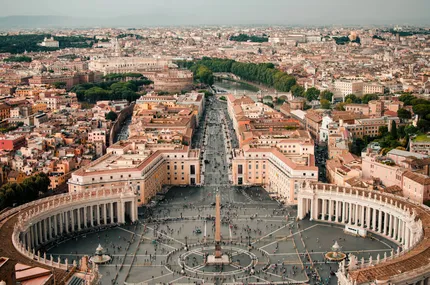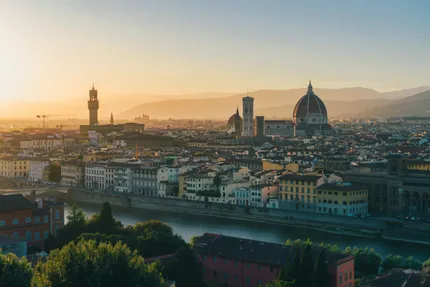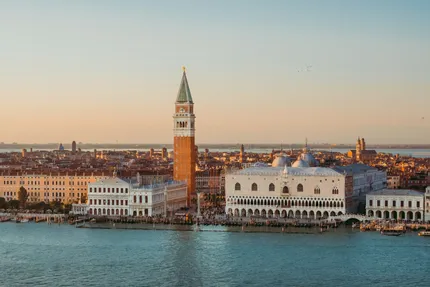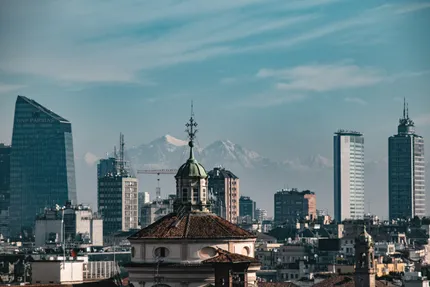CityTouring
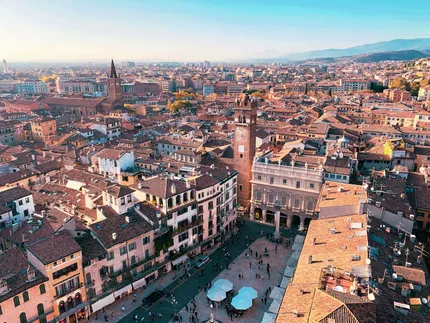
City trip to Verona
ItalySet on a curve of the Adige River, Verona blends Roman grandeur with medieval elegance and lively northern Italian street life. The UNESCO-listed historic center is compact and easy to explore on foot: the first stop is often the 1st-century Arena, still used for open-air opera in summer. From there, stroll to Piazza delle Erbe’s market stalls and frescoed facades, climb Torre dei Lamberti for citywide views, and cross the crenellated Ponte Scaligero to Castelvecchio’s museum. Roman layers appear again at the Teatro Romano and the stone arch of Ponte Pietra, while the Romanesque Basilica of San Zeno offers a calmer highlight.
Literature fans detour to Casa di Giulietta; food lovers find osterie pouring Valpolicella wines and plates of risotto all’Amarone. With trains running through Porta Nuova station and a network of local buses, Verona makes logistics simple, and its nightlife is concentrated around Via Mazzini and Piazza dei Signori. Lake Garda, Valpolicella vineyards, and the walled town of Soave sit within easy reach, giving the city a rare mix of urban culture, dining, and quick countryside escapes.
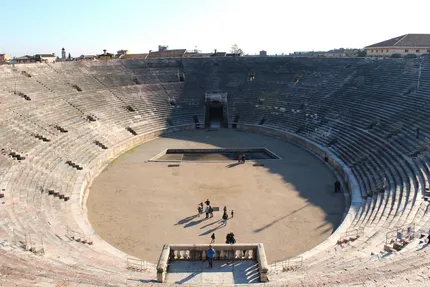
Arena di Verona
Verona's 1st-century Roman amphitheatre is remarkably intact and still hosts spectacular summer opera. Visit by day to admire the elliptical tiers, radial corridors, and limestone arches; return at night for performances under the stars. Set on Piazza Bra, the Arena offers self-guided and guided visits, plus occasional access to upper sections for views.
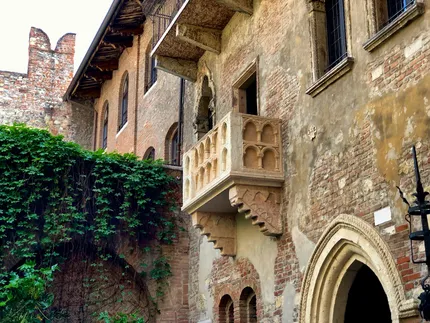
Juliet's House (Casa di Giulietta)
Medieval Casa di Giulietta draws crowds to its stone courtyard, bronze Juliet statue, and photogenic balcony linked to Shakespeare's tale. Inside, a small museum displays period rooms, costumes, and exhibits about the legend. Arrive early or late to avoid queues, and note timed entry for the house; courtyard access is free.
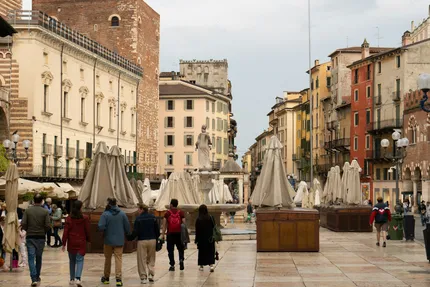
Piazza delle Erbe
Once Verona's Roman forum, this lively square mixes market stalls with frescoed palazzi, medieval towers, and the Baroque Madonna Verona fountain. Surrounded by cafes and historic buildings, it's ideal for people-watching and orientation. Climb nearby Torre dei Lamberti for views, then wander to adjacent Piazza dei Signori through the Arco della Costa.
Verona suits city-break travelers who like substance packed into a walkable core. Opera fans can plan a focused weekend around a performance at the Arena, pairing it with Castelvecchio, San Zeno, and dinner in an osteria serving local cuisine and Valpolicella by the glass. Architecture and history enthusiasts get a clear timeline from the Arena and Roman Theater to Scaliger fortifications and Renaissance palazzi, all within a 20-minute radius on foot. Wine-minded visitors base here to taste in Valpolicella or Soave and still be back for aperitivo in Piazza delle Erbe; organized tastings and half-day vineyard tours are easy to arrange. Couples find plenty of low-key romance in riverside walks, sunset views from Castel San Pietro (via funicular), and quiet cloisters at San Zeno. Photographers will appreciate early-morning markets, bridge silhouettes over the Adige, and rooftop panoramas from Torre dei Lamberti.
Families who prefer manageable cities will value short distances, traffic-calmed lanes, gelato stops, and green pauses in Giardini Giusti. Active travelers can add gentle cycling along the Adige or out to winery roads, then recover in wine bars near Via Mazzini. If you want nightlife that runs late into the small hours, look elsewhere; Verona is more about conversation, culture, and good food than clubs. For a two-to-three-day break, it’s an easy, rewarding fit. Day trips are simple by bus or train to lakeside towns on Lake Garda, the hilltop castle at Soave, or tasting rooms across Valpolicella.
Three top reasons for a city trip to Verona
- Experience Verona's Roman grandeur at the Arena in Piazza Bra: a preserved amphitheatre hosting summer opera, celebrated acoustics; wander to Roman gates, medieval lanes, and Renaissance palazzi surrounding the center.
- Trace Shakespearean romance at Casa di Giulietta on Via Cappello: famed balcony, bronze statue, love-note covered walls, and courtyard; then visit Juliet's Tomb and viewpoints for sunset views over Verona.
- Savor Veronese cuisine and vineyards: risotto all'Amarone, bollito misto with pearà, pastissada de caval, tortellini di Valeggio, Monte Veronese cheese; sip Valpolicella, Amarone, and Soave in convivial osterie and piazzas.
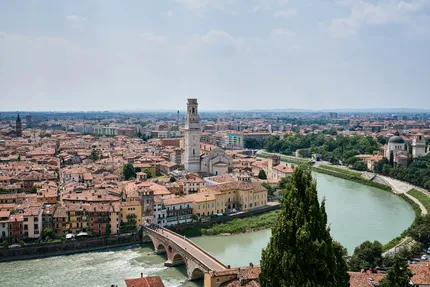
Best time to visit Verona
April to June and September to mid-October are the sweet spots. Spring brings mild temperatures, long daylight, blooming riverbanks, and fewer tour groups than peak summer; it’s ideal for sightseeing and terrace dining. Early summer adds the opening nights of the Arena Opera Festival, but also higher prices and crowds as July-August heat rises. In autumn, grape harvests enliven nearby Valpolicella and Soave, hotel rates soften, and days remain comfortable for walking. Winter is chillier and sometimes foggy, yet atmospheric, with Christmas markets and lighter museum queues. Whenever you come, book ahead for opera nights and major fairs like Vinitaly.
More activities and things to see in Verona:
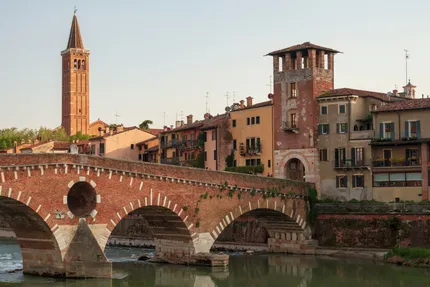
Ponte Pietra & Adige Riverside Walk
Verona's oldest bridge, the Roman Ponte Pietra, links the old town to the Roman Theatre hillside. Reconstructed after wartime damage, it combines Roman and medieval arches. Cross for classic photos, then follow riverside promenades to admire fortifications, arches, and bridges, or ascend to Castel San Pietro by steps or the funicular.
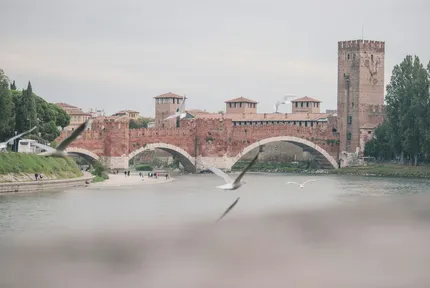
Castelvecchio & Ponte Scaligero
Scaliger-era Castelvecchio is a brick fortress housing an excellent civic museum of medieval to Renaissance art, including works by Pisanello, Mantegna, and Veronese. Walk the crenellated walls and cross the adjoining Ponte Scaligero for sweeping river views. The bridge, rebuilt after WWII destruction, is a favorite at sunset and for photography.
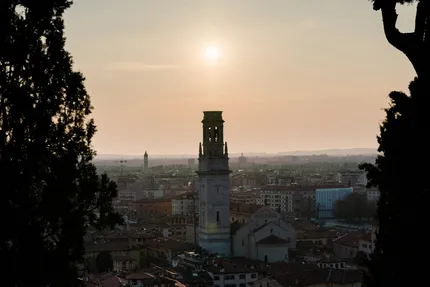
Torre dei Lamberti
An 84-meter medieval tower rising above Piazza delle Erbe, the Torre dei Lamberti offers Verona's best panorama. Reach the top by stairs or elevator and identify landmarks from the viewing gallery. The tower's historic bells, Marangona and Rengo, once regulated city life. Combined tickets often include the adjacent Palazzo della Ragione.
Basilica di San Zeno Maggiore
Verona's Romanesque masterpiece features striped stone facades, a luminous rose window known as the Wheel of Fortune, and magnificent 12th-century bronze door panels. Inside are vivid frescoes, a serene crypt, and an important high altar with a copy of Mantegna's altarpiece. The adjoining abbey courtyard adds atmosphere and historical context.
Roman Theatre & Archaeological Museum
Built into the San Pietro hillside above the Adige, the 1st-century Roman Theatre retains terraces and stage remains used for summer performances. The adjacent Archaeological Museum, in a former convent, displays mosaics, sculptures, inscriptions, and everyday objects. Expect superb viewpoints over Ponte Pietra and the old town from terraces and cloisters.
Verona Cathedral (Duomo Complex)
Explore the Duomo complex: the Cathedral of Santa Maria Matricolare, baptistery San Giovanni in Fonte, and Church of Sant'Elena with early Christian remains. Inside the cathedral, note Romanesque-Gothic architecture, chapels, and Titian's Annunciation. A single ticket covers multiple sites, making this cluster efficient to visit while learning Verona's layered sacred history.
Giardino Giusti
A finely preserved Renaissance garden across the river, Giardino Giusti rewards with cypress-lined avenues, statues, a hedge maze, and a cool grotto. Climb to the belvedere terrace for sweeping views over Verona's rooftops and towers. The adjacent palazzo occasionally opens rooms, offering glimpses of period interiors and the family's historic collections.
Scaliger Tombs (Arche Scaligere)
Near Santa Maria Antica, the Arche Scaligere are ornate Gothic funerary monuments of Verona's medieval rulers. Elaborate canopies, iron grilles, and equestrian statues commemorate the della Scala lords, including Cangrande I. The small enclosure vividly illustrates 14th-century civic power and style, and it pairs well with a circuit of nearby squares and palaces.
Piazza dei Signori
An elegant, enclosed square ringed by palaces: the Loggia del Consiglio, Palazzo del Podesta, and Palazzo della Prefettura - Piazza dei Signori was Verona's political heart. A statue of Dante recalls his exile here. Arched passages link it to Piazza delle Erbe and the Scaliger Tombs, making it a natural stop on any central walking route.
Getting around in Verona
Verona’s historic center is compact, level, and largely within a ZTL (limited-traffic zone), so walking is the easiest way to reach most sights around Piazza Bra, the Arena, Piazza delle Erbe, and along the Adige. Bridges are frequent, but wear good shoes for cobbles and short slopes. Cycling is practical: there are signposted riverside paths and growing on-street lanes; several shops rent bikes and e-bikes, and hotels often provide them. A short funicular links the area near Ponte Pietra to Castel San Pietro for panoramic views. Public transport is by ATV buses, which cover the center, suburbs, and outlying towns; services are frequent on main corridors but thin late at night. Buy and validate tickets via the ATV app, at tabacchi, or station kiosks; day passes and the VeronaCard (which includes city buses) are good value. Taxis are reliable at ranks and by app; ride-hailing is limited. A car is unnecessary in town and difficult to park; rent one only for day trips to Valpolicella, Soave, or Lake Garda.
Getting to Verona
Verona’s airport is Verona Villafranca (VRN, "Valerio Catullo"), about 10 km southwest of the center. The Airlink shuttle runs every 20 minutes to Verona Porta Nuova station in roughly 15 minutes. VRN has year-round flights to major Italian cities and European hubs (notably Munich and Frankfurt), plus seasonal services to other destinations; low-cost carriers and charters are common. For broader options, Venice Marco Polo (VCE), Bergamo Orio al Serio (BGY), and Milan Linate/Malpensa are 1–2 hours away by train or coach. By rail, Verona Porta Nuova is a key node: frequent Frecciarossa, Italo, and Frecciargento trains link Milan, Venice, Bologna, Florence, Rome, and Turin; regional trains reach Lake Garda, Vicenza, Padua, Trento, and Bolzano. International EuroCity trains run via the Brenner Pass to Innsbruck and Munich, and Nightjet sleepers connect to Vienna and Munich. Long-distance buses (FlixBus, Itabus) operate to Milan, Venice, Bologna, Rome, and cross-border routes, using stops near Porta Nuova. Driving access is via the A4 (Milan–Venice) and A22 (Brenner–Modena) motorways.
